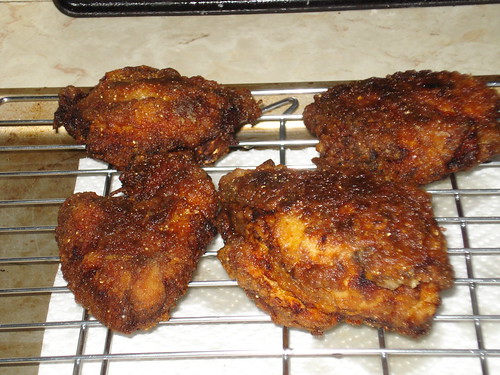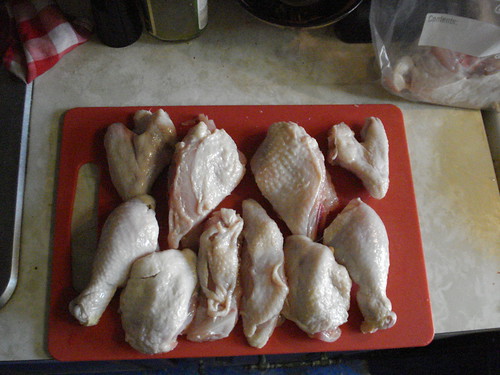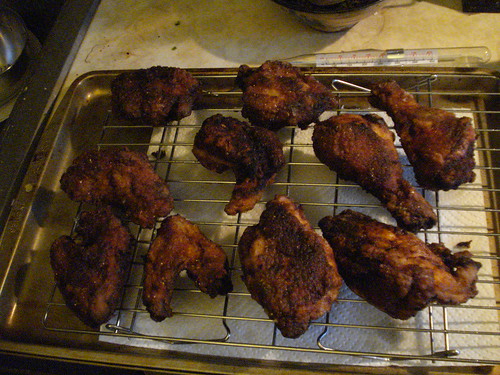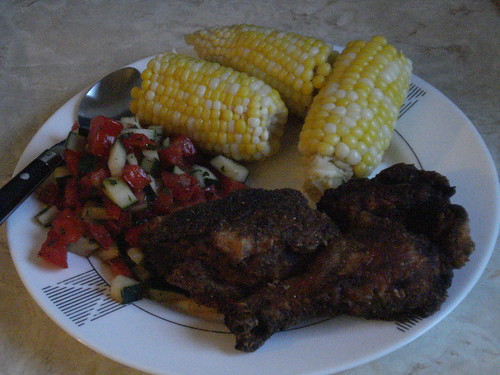fried chicken
 Martha Stewart’s Cooking School is one of my big, thick comprehensives. It’s organized by kind of food and technique; for example, the chapter on stocks and soups is divided into types such as white stock, brown stock, dashi and consomme; the chapter on meat, fish and poultry treats roasting, grilling, braising, steaming, and frying rather than being organized into beef, chicken, and fish. Detailed steps and the kind of stunning photographs for which Martha Stewart is known make it easy to see what to do at every stage of the process.
Martha Stewart’s Cooking School is one of my big, thick comprehensives. It’s organized by kind of food and technique; for example, the chapter on stocks and soups is divided into types such as white stock, brown stock, dashi and consomme; the chapter on meat, fish and poultry treats roasting, grilling, braising, steaming, and frying rather than being organized into beef, chicken, and fish. Detailed steps and the kind of stunning photographs for which Martha Stewart is known make it easy to see what to do at every stage of the process.
 With over 250 recipes to choose from, why did I pick fried chicken? Because it scared me. I don’t fry much. It’s not that I’m concerned about eating fried food (although I probably should be); it’s the mess. Spattering oil, cleaning up the pan, cleaning up the stove. I’m also a little bit afraid of burning and smoke, so I thought that Martha Stewart’s instructions might be the ones to use to make sure I’d accounted for everything and prevented any problems.
With over 250 recipes to choose from, why did I pick fried chicken? Because it scared me. I don’t fry much. It’s not that I’m concerned about eating fried food (although I probably should be); it’s the mess. Spattering oil, cleaning up the pan, cleaning up the stove. I’m also a little bit afraid of burning and smoke, so I thought that Martha Stewart’s instructions might be the ones to use to make sure I’d accounted for everything and prevented any problems.
 You could start with a pre-cut-up chicken, but I chose to follow Stewart’s instructions to cut up a whole chicken, including cutting the breast piece into two for more even cooking. I’m not very good at cutting up a chicken, though I’m getting better with practice. It helps to flex the bird at the joints so you can get a clearer idea of where the sockets are and cut more easily between the bones; that makes for neater pieces. I did fairly well with this one, though when I cut the breast pieces in two I did a messier job with one; instead of a neat sort of triangular piece, I had a kind of raggedy piece.
You could start with a pre-cut-up chicken, but I chose to follow Stewart’s instructions to cut up a whole chicken, including cutting the breast piece into two for more even cooking. I’m not very good at cutting up a chicken, though I’m getting better with practice. It helps to flex the bird at the joints so you can get a clearer idea of where the sockets are and cut more easily between the bones; that makes for neater pieces. I did fairly well with this one, though when I cut the breast pieces in two I did a messier job with one; instead of a neat sort of triangular piece, I had a kind of raggedy piece.  It definitely helps to have a good sharp chef’s knife, which is very good for cutting through the breastbone and any other tougher areas. You want to end up with 10 pieces: two each of wing, thigh, drumstick, upper breast half and lower breast half. The back will be left over; I froze it for making stock later this year.
It definitely helps to have a good sharp chef’s knife, which is very good for cutting through the breastbone and any other tougher areas. You want to end up with 10 pieces: two each of wing, thigh, drumstick, upper breast half and lower breast half. The back will be left over; I froze it for making stock later this year.
The chicken pieces are marinated in the fridge for at least three hours in buttermilk seasoned with mustard powder, Old Bay seasoning, cayenne, salt and pepper; I let mine marinate overnight. About an hour before it’s time to start frying, you take the chicken out of the fridge and lay the pieces on a rack  over a baking sheet; this allows the chicken to come closer to room temperature, the excess marinade to drip off, and the remaining marinade to get a bit tacky so it will hold the coating better.
over a baking sheet; this allows the chicken to come closer to room temperature, the excess marinade to drip off, and the remaining marinade to get a bit tacky so it will hold the coating better.
While the chicken rests, you whisk together some flour, yellow cornmeal, cayenne, salt and pepper. Stewart’s instructions recommend starting with only half the dredging mixture; I mixed the full amount but put only half into a shallow bowl for dredging, and held the rest aside in case  I needed more. That half turned out to be plenty to coat the chicken, so I was able to save the remainder for another use knowing it hadn’t been in contact with raw chicken.
I needed more. That half turned out to be plenty to coat the chicken, so I was able to save the remainder for another use knowing it hadn’t been in contact with raw chicken.
I used my cast-iron skillet; you have to get the oil very hot, about 375 degrees, so I wouldn’t have wanted to use a cheap or flimsy pan. I poured in only about half an inch — after all, you’re not immersing the full piece of chicken but cooking each side and turning partway through. While the oil heated, I dredged the chicken. Then, borrowing a technique from an episode of “Good Eats,” I used one  set of tongs to handle the not-yet-cooked pieces and to turn them partway through, and another set of tongs to remove the finished pieces from the pan, to avoid any risk of contamination. (I won’t go into my rant about why it’s insane that food industry practices are such that individual consumers are now instructed to handle raw meat as if it’s radioactive waste.)
set of tongs to handle the not-yet-cooked pieces and to turn them partway through, and another set of tongs to remove the finished pieces from the pan, to avoid any risk of contamination. (I won’t go into my rant about why it’s insane that food industry practices are such that individual consumers are now instructed to handle raw meat as if it’s radioactive waste.)
 This recipe calls for heating the oil to 375 and cooking the pieces for 5 minutes per side. I thought that sounded awfully fast, but clearly it was ample time. The recipe also says to put as many pieces into the skillet as will fit without touching; I didn’t think I could fit in all 10 pieces without crowding, so I chose to do five pieces at a time, one of each variety, so that both batches would be the same. With a slightly larger skillet or a slightly smaller bird I might have been able to do it in one batch.
This recipe calls for heating the oil to 375 and cooking the pieces for 5 minutes per side. I thought that sounded awfully fast, but clearly it was ample time. The recipe also says to put as many pieces into the skillet as will fit without touching; I didn’t think I could fit in all 10 pieces without crowding, so I chose to do five pieces at a time, one of each variety, so that both batches would be the same. With a slightly larger skillet or a slightly smaller bird I might have been able to do it in one batch.
 As soon as I started to add chicken to the oil, the moisture caused bubbling and a bit of spattering. You have to be very careful at this stage; you don’t want to drop chicken pieces into the oil, and you want to make sure there isn’t any extraneous moisture on the chicken or your tongs that could pop and spray hot oil at you. That would be bad. I got a little bit spattered when I added the first batch of chicken pieces — nothing serious, and a quick rinse under cold water put me right. The recipe also says to cover the pan to prevent spattering and ensure even heating, but I didn’t have a lid that was large enough, or a splatter guard. A splatter guard might have made the after-dinner stovetop cleaning a bit easier, but I think a lid would have trapped steam as well as oil, which I don’t think could be good.
As soon as I started to add chicken to the oil, the moisture caused bubbling and a bit of spattering. You have to be very careful at this stage; you don’t want to drop chicken pieces into the oil, and you want to make sure there isn’t any extraneous moisture on the chicken or your tongs that could pop and spray hot oil at you. That would be bad. I got a little bit spattered when I added the first batch of chicken pieces — nothing serious, and a quick rinse under cold water put me right. The recipe also says to cover the pan to prevent spattering and ensure even heating, but I didn’t have a lid that was large enough, or a splatter guard. A splatter guard might have made the after-dinner stovetop cleaning a bit easier, but I think a lid would have trapped steam as well as oil, which I don’t think could be good.
 So the cooking itself is very simple: add pieces skin side down, cook for five minutes, turn, cook another five minutes, then remove to a rack to drain off excess oil. Stewart suggests holding cooked pieces in the oven if you’re doing more than one batch, but I didn’t bother. For one thing, fried chicken is good at any temperature; for another, it was hot enough in my kitchen without turning on the oven as well; and for yet another, I didn’t think the first batch would cool enough in 10 minutes to make a real difference.
So the cooking itself is very simple: add pieces skin side down, cook for five minutes, turn, cook another five minutes, then remove to a rack to drain off excess oil. Stewart suggests holding cooked pieces in the oven if you’re doing more than one batch, but I didn’t bother. For one thing, fried chicken is good at any temperature; for another, it was hot enough in my kitchen without turning on the oven as well; and for yet another, I didn’t think the first batch would cool enough in 10 minutes to make a real difference.
 Verdict: Success. The chicken was delicious, with moist, juicy meat and a crispy, satisfying crust. Of course, the whole process was rather messy, and I had a fair bit of oil to dispose of when it had cooled down. (I don’t plan to fry again soon, so thought that if I filtered and saved the oil for re-use it would be very likely to go bad before I could use it.) I think it might make sense to do this for a large gathering, or at least it would be for someone whose friends aren’t mostly vegetarians. But I’m pretty unlikely to try it again before the weather cools down.
Verdict: Success. The chicken was delicious, with moist, juicy meat and a crispy, satisfying crust. Of course, the whole process was rather messy, and I had a fair bit of oil to dispose of when it had cooled down. (I don’t plan to fry again soon, so thought that if I filtered and saved the oil for re-use it would be very likely to go bad before I could use it.) I think it might make sense to do this for a large gathering, or at least it would be for someone whose friends aren’t mostly vegetarians. But I’m pretty unlikely to try it again before the weather cools down.
The fried chicken was, in fact, of a delicious nature. Also: juicy, like couture.